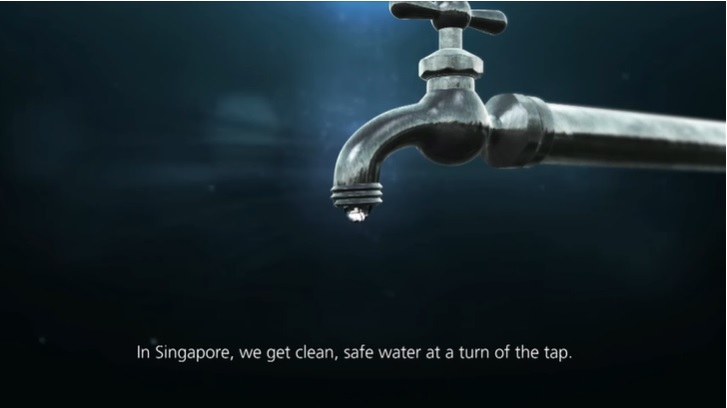PM Mahathir’s close aide Kadir Jasin, speaking at the question-and-answer session at the ISEAS-Yusof Ishak Institute, said that unless Singapore has a “magic wand that says water, water, drop all over Singapore,” Singapore will always need to rely on foreign countries for water. This was in response to a question posited by a member of the audience regarding the water price dispute between Singapore and Malaysia.
Water Imports from Malaysia
Two water agreements between Malaysia and Singapore were signed in 1961 and 1962, the first of which was terminated in 2011 and the second will end in 2061. The current (second) agreement still provides up to 250 mgd (1 137 000 m3/d, 13.16 m3/s). This water enters Singapore through a pipeline at the causeway between Singapore and Johor, Malaysia.
Singapore and Malaysia have a long history of water import agreements that goes back to as early as 1927. A new round of water negotiations began in 1998 which was associated with economic packages that focused on recovery efforts from the Asian financial crisis.
By 2003, Singapore had begun to look seriously for alternative water sources, including importing from Indonesia, and ultimately the negotiations with Malaysia ended without agreement. With the expiry date of 2061 for the second agreement approaching, this has become the de facto planning horizon for Singapore to advance and diversify its technologies as it moves towards the goal of water self sufficiency.
Is Kadir right? Will Singapore really run out of water without Malaysian supply?
In Singapore, water is not just any other commodity. The government may subsidise housing, healthcare, education, but never water consumption.
In the tiny state, water is a strategic issue. It is likewise a national security issue. It needs to be priced fully. The consumer must feel the price of water, realise how valuable water is every time he or she turns on the tap, right from the first drop.
Harry Seah, Chief Technology Officer of PUB, Singapore’s water agency, said that without importing millions of litres from Malaysia every year, Singapore would simply not survive.
Thus, it is his job to find new ways to keep Singaporeans topped up with their blue gold. Singapore must have surplus water without overseas reliance. But how will Singapore do it?
Being creative with technology
The approach the government is taking is to re-use as much water as possible, like rainwater. The country has 17 reservoirs, covering two thirds of the island. But land is at a premium – Singapore is only 710 square kilometres – and digging up more reservoirs is not feasible, Seah says.
So the second option is more feasible – reusing as much water as possible. It’s the “only way to solve the problem,” the PUB engineer said. Since 2003, Singapore has been recycling sewage and turning it into drinking water.
These initiatives have been pushed and heightened. The fifth recycling plant began operating in 2018 and, by 2060, 55% of the country’s water will come from these plants, he says. It’s “the key” to the nation’s strategy.
The question now is — how can this be safe? Seah’s response is technology. According to the engineer, everything is fitted with sensors, from the factories to the pipes leading to citizens’ homes. “Every drop of water we send out must be safe,” he says. The Internet of Things is crucial to this.
This was a bold step, yet the plant has been operating in seven months, turning out water that exceeds World Health Organisation standards.
Another question cropped up — “How do I tell the public it is safe?”, Seah says. The brand ‘NEWater’ was picked because it “softens” the term, focusing on freshness not its provenance.
PUB has been “very careful with the words we use,” he added. There is no mention of ‘wastewater’ in PUB’s document on its 50-year strategy. Instead, it is “used water” and sewage plants are termed “water reclamation plants.”
The country is on the right track, and then another problem presents itself. Water recycling consumes a tremendous amount of energy – another resource that Singapore lacks.
“Today’s technology only buys us time,” he says. His agency then has responded by building a culture of experimentation, trialling every approach, seizing on every idea. “We don’t say no to any ideas. We never say no; we say yes, always yes”, he insists. “Every idea is welcome, and every proposal must be explored.”
Every Singaporean must save water
PUB anticipates increased demand but they want Singaporeans to be a little thriftier.
If everyone in Singapore saves five and half litres of water a day, it would save a huge amount of water and energy for the future, he says. “Even if the economy and population double, we [should] still use the same amount of water,” he believes.
The challenge is to change the culture. Seah wants people to realise that conserving water is a national duty. “It technically isn’t your water. I loaned it to you, I want it back,” he says.
Technology plays a big role, Seah believes. PUB is installing automatic water meter readers in homes, allowing citizens to track their water use by the hour. “We would like to feed the public as much information in real-time as possible”, he says.
The agency is running a two and half year pilot, testing how more information on water usage changes Singaporeans’ habits. By promoting the idea of saving money, they hope to naturally reduce consumption.
Seah believes that this island will one day become self-sufficient, a lot different from what Kadir imagines will happen.
/TISG

